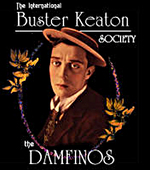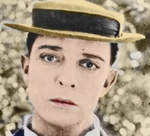The International Buster Keaton Society held its 13th annual convention
at the Fruenthal Theatre Complex on Friday and Saturday.
The crowd of about 40 enthusiastic Keaton fans and scholars met to
discuss the great silent film director and comedian, tour Keaton's
native Bluffton area of Muskegon and view some of the director's great
works.
Among particular interest was the Friday night screening of a newly
discovered, early edit of Keaton's 1923 comedy "Our Hospitality."
It was the new screening drawing in the larger-than-average crowd,
said Ron Pesch, local historian and convention attendee.
Convention participants, some of whom traveled from as far away as
the United Kingdom, ranged in age from college students to senior
citizens. Many sported their own, homemade porkpie hat in tribute to
Keaton while audience members also entertained themselves with
intentionally arcane quizzes and trivia.
In addition, the convention featured lectures and panel discussions
with scholars George Weade, Imogen Smith and Annette Lloyd - the latter
of which is the author of four books about Keaton's contemporary, Harold
Lloyd, no relation.
One discussion at the convention focused on the differences between
the two versions of "Our Hospitality," and why those differences came to
be. Made in 1923, the film features a love story twisted into a bitter
feud between two families. Patricia Eliot Tobias, president of the
Muskegon Actor's Colony - the group who hosts the annual Buster Keaton
Convention - lead this discussion.
"One of the great things about being the founder of this group with
this amazing array of scholars and people who are so knowledgeable is
that every year we have the opportunity to present original research,"
Tobias said.
Tobias said she believes "the Damfinos" had a positive effect on
lessening "pretentious" research and analysis into his films that Keaton
would not have appreciated. The group takes its unique name from a
vessel featured in the 1921 short "The Boat" and has the double meaning
of "Damn fine" and "Damned if I know."
Comedian Keaton -- a child star in Vaudeville near the turn of the
20th century -- reached great success in the '20s with a string of
comedic masterpieces. His run of stardom began to fade when he signed a
contract with MGM studios, which gradually removed his creative control
of his films and altered his signature character.
Keaton spent most of the '30s and '40s as a minor player in features
or a star in low budget shorts. He experienced a comeback in the '50s
when his silent work began to be appreciated once more, and he worked
steadily in film and television. Around the time of his death from lung
cancer in 1966, he had begun to be lauded as one of the greatest of all
filmmakers.
The convention ended with a screening of two of Keaton's 35mm silent
classics, "Battling Butler" and "The Navigator," with live musical
accompaniment from organist Dennis Scott. The screenings were open to
the public and heavily attended.
Led by local historian Ron Pesch, Friday afternoon's walk lasted
less than two hours and spanned back more than 100 years.
Returning to the early 1900s over the course of a few Muskegon
blocks, more than 30 members of the Damfinos -- the fan club of the
late silent-film comedian Buster Keaton -- repeated a ritual:
strolling the neighborhood known as Bluffton.
There, once stood The Actors' Colony, a show-business enclave
co-founded by vaudeville entertainer Joe Keaton, Buster Keaton's
father. Damfinos are wont to quote Keaton, from his biography, "My
Wonderful World of Slapstick," that, "The best summers of my life
were spent in the cottage (his father) had built on Lake Muskegon
(make that Muskegon Lake) in 1908."
In the ghost of The Actors' Colony (1908-1938), everything old is
new again.
Each year, Pesch said, "I keep discovering stuff, as we're
walking through the colony."
 |
The Actors' Colony, of which Buster Keaton was a
member, gather at their clubhouse, known as the Theatrical
Colony Yacht Club, in the Bluffton neighborhood in the early
1900s. |
|
What: Buster Keaton Film Festival.
When: 8 p.m. Saturday.
Where: Frauenthal Theater, 425 W.
Western, in downtown Muskegon.
Admission: $6 at the door.
More: Silent films to be screened are
"Battling Butler" (1926) and "The Navigator" (1924). Chicago
theater organist Dennis Scott will accompany the movies on
the Frauenthal's pipe organ.
Online:
www.busterkeaton.com
and
www.actorscolony.com
|
Think of it as neighborly: During the 14 consecutive Octobers
that the Damfinos have conducted their fall convention in Muskegon,
current Bluffton residents have not only come out of their homes to
greet them during the walking tour, but also to share memories of a
famous past.
"It's a blast to walk through there," said Pesch, "because they
know that in October some of those Keaton folks will be walking
through there. And they're kind of hanging out, maybe getting ready
to go to the football game or something. And as we're walking
through the neighborhood, they'll throw out a story every now and
then."
Such stories: tales of living near The Actors' Colony ice house,
the walls of which were 12 inches thick and filled with sawdust;
pointing out a vacant lot and remembering the general store that
used to stand there; cross-referencing a now nonexistent address on
Wilcox Street, to discover a dwelling that once served as a flop
house for sawmill workers, and perhaps the early carnation of the
comic who became famous as The Great Stoneface.
Buster Keaton might have sought refuge in that house -- which is
in the 3300 block of Wilcox -- when the turmoil of his home life
became too much to stand.
Before he became a movie star peer of two other silent comedy
giants, Charlie Chaplin and Harold Lloyd, Keaton - who later became
famous for wearing an iconic porkpie hat and blank expression - was
the youngest member of a family vaudeville act.
The act disintegrated as Keaton's father, Joe, a co-founder of
The Actors' Colony, increasingly spun out of control with his liquor
consumption.
"When Buster left Muskegon for New York, he was about 22 years
old," Pesch said. "And we all know that part of the reason that he
left the act was Joe, at that point, was becoming kind of a violent
drunk on stage."

Joe
Keaton not only bought a Muskegon summer home for his family,
but also a several other nearby properties. Did Buster seek
shelter in one of them? Don't know for certain, said Pesch, but
maybe.
Though the Damfinos were on foot Friday, their passion for Keaton
is hardly pedestrian. Since 1994, members of the society on the
first weekend of October have congregated in Muskegon. Their
gathering reunites them in their shared passion for Keaton, a genius
whose happiest days were the youthful summers, beginning in the
early 1900s, he spent near and on Muskegon Lake.
Lisa Tatge, a software engineer for the NASA Jet Propulsion
Laboratory in Pasadena, Calif., has been coming here for the
Damfinos convention since 2001. Since then she has missed only last
year, when she was working on the launch of the Dawn mission's
exploration of the asteroid belt.
 Tatge
said she first got hooked on silent films in 2000, when two broken
eardrums made hearing difficult for her. Her first silent film was
1928's "The Wind" starring Lillian Gish.
Tatge
said she first got hooked on silent films in 2000, when two broken
eardrums made hearing difficult for her. Her first silent film was
1928's "The Wind" starring Lillian Gish.
"At that time, I didn't understand how you could have such a
beautiful film that said so much without saying anything," Tatge
said of "The Wind." "It just absolutely captivated me."
Keatonmania was not far behind, starting with Tatge seeing
Keaton's film "Sherlock Jr." on television.
"I could not believe some of the stunts that were done in the
film," she said, "some of the effects that were done or, as it turns
out, not done in the film ... They were doing vaudeville tricks.
"So you got kind of intrigue by this whole process of how they
made the films. And It was such a great story. I think I called my
mom shortly afterwards and I said, 'You know what? I like this
Buster Keaton guy.'"
In Muskegon, Pesch helps put things in perspective.
"Ron's got such great info about all of the history in the area,"
Tatge said. "Most people who are into silent films are into the
history as well, and (history) was one of the subjects I liked when
I was in school."
Before this year's walk began at 4 p.m., some of the Damfinos
participated in a short softball game on the sand dune-backed
diamond adjacent to Bluffton Elementary School, 1875 Waterworks, the
same field on which the Keatons and their cronies once played.
The game was a block from where Waterworks butts into Lakeshore
Drive just past Keaton Court, the location of a state of Michigan
historical marker commemorating Keaton and The Actors' Colony.
Friday's walking tour was restricted to people registered for the
2008 convention, but Pesch occasionally leads public tours of The
Actors' Colony. He did so Labor Day weekend, and also a week ago.
Not that folks need Pesch or anyone to personally show them where
to go. Pesch has established an online Web site —
www.actorscolony.com — for
The Actors' Colony. On it is a map of the walking tour, replete with
designated points of interest.
Among them:
• The former location of Pascoe's Place, a tavern (razed in 1960)
where colony denizens drank, ate lake perch and carried on.
• 1579 Edgewater, the site of "Jingles Jungle," the Keaton
cottage that was removed in the 1950s.
• 1831 Cherry, from where vaudevillians Max and Adele Gruber, who
had an animal novelty act on the vaudeville circuit, were known to
ride one of their elephants, Millie, along Bluffton's streets.
• 1705 Edgewater, where agent William "Mush" Rawls and his wife
settled in 1900. When the TV show "This is Your Life" in 1957
honored Buster Keaton, Rawls appeared to reminisce about Keaton's
time in Bluffton.
The International Buster Keaton Society was founded in 1992.
Although most of this weekend's activities are confined to members
registered for the convention, the Damfinos will go public tonight,
for the Buster Keaton Film Festival. In the 1,725-sea auditorium,
Lisa Tatge figures to be in the front row.
"I'll have my porkpie hat on," she said. "It's kind of hard to
miss me."

 The
great debate over who was the best silent comedian -- Charlie
Chaplin or Buster Keaton? -- has raged for nearly a century. If the
number of recent screenings at the Michigan, Redford and Detroit
Film Theatre is any indication, then Keaton, known as "the great
stone face" for his expressionless delivery, wins hands down.
The
great debate over who was the best silent comedian -- Charlie
Chaplin or Buster Keaton? -- has raged for nearly a century. If the
number of recent screenings at the Michigan, Redford and Detroit
Film Theatre is any indication, then Keaton, known as "the great
stone face" for his expressionless delivery, wins hands down.


 Joe
Keaton not only bought a Muskegon summer home for his family,
but also a several other nearby properties. Did Buster seek
shelter in one of them? Don't know for certain, said Pesch, but
maybe.
Joe
Keaton not only bought a Muskegon summer home for his family,
but also a several other nearby properties. Did Buster seek
shelter in one of them? Don't know for certain, said Pesch, but
maybe. Tatge
said she first got hooked on silent films in 2000, when two broken
eardrums made hearing difficult for her. Her first silent film was
1928's "The Wind" starring Lillian Gish.
Tatge
said she first got hooked on silent films in 2000, when two broken
eardrums made hearing difficult for her. Her first silent film was
1928's "The Wind" starring Lillian Gish.